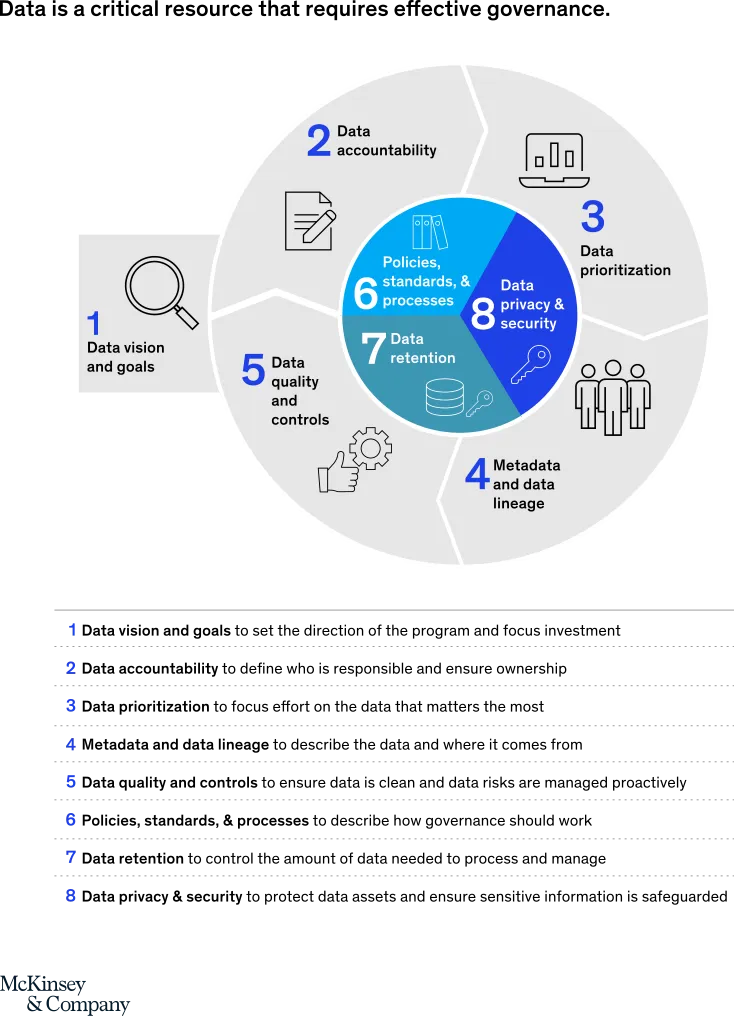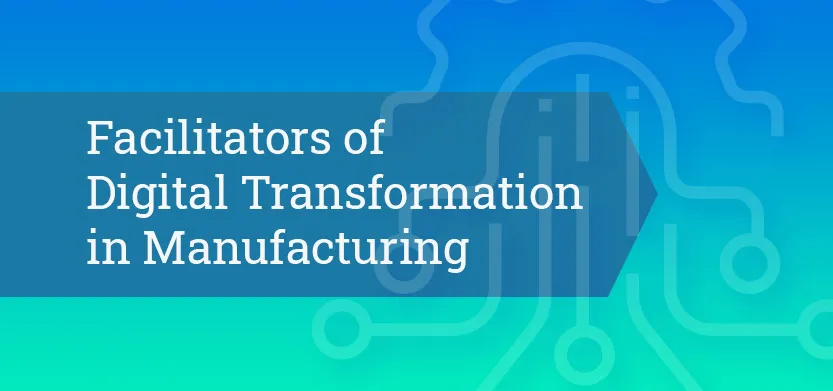

Posted in Digital Transformation
March 7, 2023
Facilitators of digital transformation in manufacturing
Manufacturing companies need facilitators in four critical areas to act as the driving force behind a digital transformation. In this article, we will take a brief look at each area and how they enable digital initiatives.
The four drivers of digital change and how they contribute to digital success.
- Talent — Without the right talent, any digital project will hit roadblocks.
- Data — Improving the use and access of data from all operational sources is one of the most important projects you can tackle.
- Technology — Review and improve the use of the tech you already have, then go for the new tech if the old tech can't cut it.
- Project management — Incremental, continuous improvement cycles, a core idea of Agile project management, is a methodology we thoroughly endorse and follow.
Businesses rely on influence and enablement in four key areas to make change possible: Talent, data management, technology and infrastructure and finally, Agile project management. These critical areas act as the driving force behind a digital transformation and will stimulate the development of digital projects from beginning to end.
“Carefully thinking through the development of digital muscles helps an organization avoid the need to repeat work or reinvent the wheel, aids the efficient use of resources, and promotes the adoption of standardized approaches that are easier to scale, replicate, and sustain.” - McKinsey & Co., Enabling a Digital and Analytics Transformation in Heavy-Industry Manufacturing
Four facilitators of digital transformation in manufacturing
The right tools, people and processes are important at every stage of a digital initiative to ensure its overall success. Let’s take a look at the four key areas that enable successful digital undertakings for manufacturers.
Talent
In manufacturing, digital projects require new capabilities — and often new roles — in three areas of the business.
- Product & production experts — Subject matter experts in the manufacturing business and the business’s unique processes that can identify areas for improvement.
- Technology specialists — Experts who can handle software development or other specialized tech needs like robotics or automation.
- Digital specialists — These people can run agile projects, design effective user experiences and build efficient workflows.
Without the right talent, any digital project will hit roadblocks. Skilled data scientists, technicians, developers and subject matter experts are hard to come by.
Making sure you have the right talent when you need it is achieved in three ways:
- Source in-house talent, either through the skills your employees may already have or by training them.
- New hires based on initiative needs. To note: If you are lucky enough to find and hire one of these specialists, you have to comprehensively onboard them so that they are familiar with your company and products. Training your existing staff can take almost as much time and resources.
- Hire contractors with the right mentality and drive to move your digital efforts forward. Look for agencies that have the exact experience you need, the subject matter experts on hand and the ability to execute.
In the writer’s humble opinion, a very effective way to build your talent pool is to create opportunities for in-house training, including workshops, and seminars and even consider creating online learning tools to create an academy-like approach to skill-building.
“Homegrown capability-building efforts can’t meet an organization’s demand for PhD-trained data scientists, but they can produce large numbers of skilled and competent digital practitioners, who are essential for the application of new tools at scale.” - McKinsey & Co., Enabling a Digital and Analytics Transformation in Heavy-Industry Manufacturing
Data
One of the most common goals in new manufacturing digital projects is to extract data from silos, integrate systems across the entire company, and bring them together in a unified, accessible form.
Most executives believe that data extraction and system integrations will mean throwing away legacy systems and building an entirely new architecture. Ripping and replacing data infrastructure is an outdated practice. Modern data platforms can be set up as a new layer that sits above existing systems and interacts flexibly with them.
An example of data integration may be using a data lake fed by data streams from various sources. These sources of data can be sensor networks, process-control systems, or other manufacturing automation equipment. Higher-level IT sources, such as enterprise resource planning (ERP) systems, can also feed into your data lake so that every operational department’s data is centrally collated.
To note: Some data sources may require additional action prior to integration. For example, some older or historical reports may exist only on paper, and non-networked or analog sensors may need to be upgraded or replaced. The rule here is to gradually integrate only the data that is needed for ongoing projects. Take a long hard look at the old data; if it won’t be used in the future, it is unnecessary to build it into your new data management system. Keep it archived so it can be manually accessed if needed, but try to move forward without it to save time and resources.
Once companies understand their data, they need to manage it. That requires robust governance policies and processes and rigorous standardization — using consistent naming conventions and a single “data dictionary” to ensure future digital projects can identify the data they need.
The following graphic from McKinsey outlines solid data governance and management practices.

Technology
When a big change is on the table, most companies take a technology-first perspective. They look at digital tools, new technologies and tools like analytics to make a change happen. But, a word of caution, new tools and technologies themselves will not guarantee that an initiative will be successful. (Take a look at our article on digital friction to see what we mean.)
Success depends more on the organization’s ability to define the problem clearly, access the appropriate data, and integrate the solution into their wider operations. New digital approaches don’t always require significant technology upgrades. Existing processes and strategies at manufacturing sites can often be tuned or reconfigured to deliver additional value, using insights from machine-learning systems or related techniques.
Companies should try to standardize processes and technology uses wherever possible, but only after evaluating those tech pieces across multiple use cases within the business. Let the people who are going to use the technology get their hands on it. Standardized procedures and uses of new tech and spend time finding ways to make it more effective. Standardization shouldn’t keep companies from improving the technologies they use.
“The digital space is fast-moving, with new solutions emerging all the time. Since frontline teams don’t have the time to keep scanning the market, it’s useful to establish a corporate group with responsibility for identifying and evaluating promising technologies. Or to build an ecosystem of collaborative relationships with a select group of technology providers.” - McKinsey & Co., Enabling a Digital and Analytics Transformation in Heavy-Industry Manufacturing
Project management
Manufacturers looking for a successful digital initiative should consider adapting to an Agile project management methodology. Rather than a waterfall methodology, where the project is handled all at once and can take years to complete, our Agile method is where development work takes place iteratively in short sprints. The emphasis in Agile is on early and continuous real-world testing and refinement.
Companies that already practice lean manufacturing will be familiar with the idea of incremental, continuous improvement cycles that Agile is based on. But even with a strong lean pedigree, companies will need to adopt new ways of working to accommodate strategic development. Read our article “Strategic Development Brings Projects to Market Faster” for more information on how Agile works at Acro Commerce and why our clients choose us over the competition.
Conclusion
Digitization at scale requires the right technical infrastructure, the right talent and the right project management skills. Luckily, most manufacturing organizations already have some of the basics in place, including a technically capable workforce, instrumented equipment, and a culture of continuous improvement. Using these foundations, companies can secure the extra talent, data, technology, and agile project-delivery capabilities they need to support their digital ambitions.
If you worry about setting your teams up for an upcoming digital initiative or need an unbiased expert opinion, reach out to our consultants to determine if you are on the right path to success. We are always here to help and want to hear about your project.
Editor's note: This article was originally published on August 3, 2021. It has been updated for accuracy and freshness.

